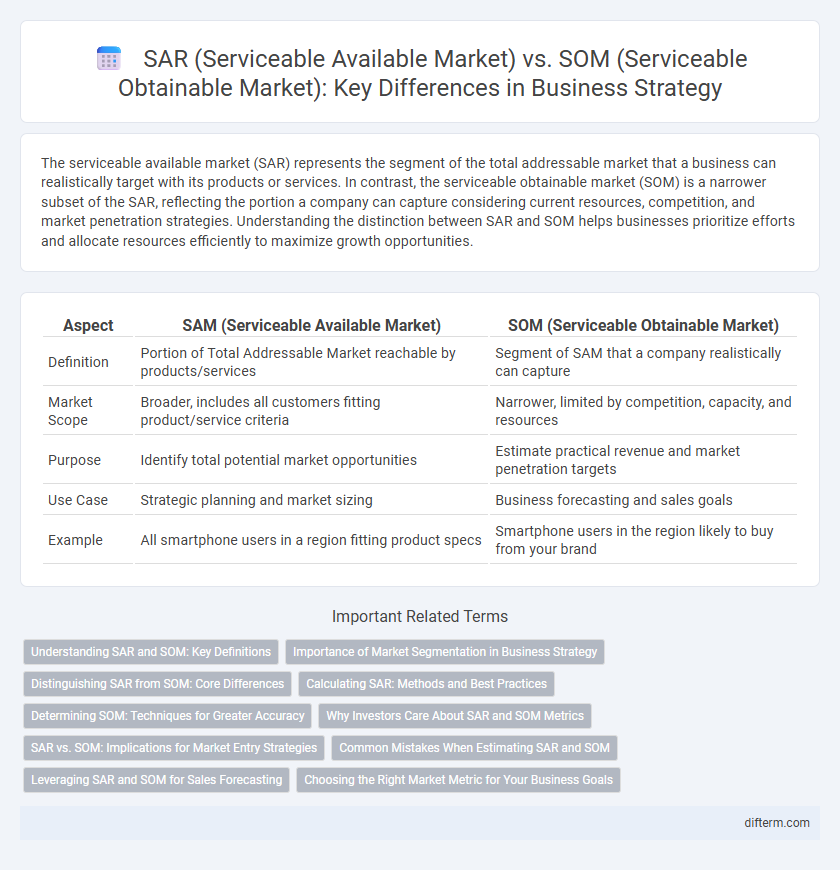The serviceable available market (SAR) represents the segment of the total addressable market that a business can realistically target with its products or services. In contrast, the serviceable obtainable market (SOM) is a narrower subset of the SAR, reflecting the portion a company can capture considering current resources, competition, and market penetration strategies. Understanding the distinction between SAR and SOM helps businesses prioritize efforts and allocate resources efficiently to maximize growth opportunities.
Table of Comparison
| Aspect | SAM (Serviceable Available Market) | SOM (Serviceable Obtainable Market) |
|---|---|---|
| Definition | Portion of Total Addressable Market reachable by products/services | Segment of SAM that a company realistically can capture |
| Market Scope | Broader, includes all customers fitting product/service criteria | Narrower, limited by competition, capacity, and resources |
| Purpose | Identify total potential market opportunities | Estimate practical revenue and market penetration targets |
| Use Case | Strategic planning and market sizing | Business forecasting and sales goals |
| Example | All smartphone users in a region fitting product specs | Smartphone users in the region likely to buy from your brand |
Understanding SAR and SOM: Key Definitions
Serviceable Available Market (SAR) refers to the segment of the total addressable market that a company's products or services can realistically serve based on current capabilities. Serviceable Obtainable Market (SOM) represents the portion of the SAR that a business can capture in the short term, considering competition, distribution channels, and market penetration strategies. Differentiating SAR from SOM helps businesses prioritize resources and develop targeted marketing plans to maximize market share effectively.
Importance of Market Segmentation in Business Strategy
Accurate delineation of the Serviceable Available Market (SAM) and Serviceable Obtainable Market (SOM) enhances precision in targeting high-potential customer segments, optimizing resource allocation. Market segmentation enables businesses to identify distinct consumer needs and tailor marketing strategies accordingly, improving conversion rates and competitive positioning. Incorporating SAM and SOM analysis into segmentation frameworks drives strategic focus, ensuring scalable growth within feasible market subsets.
Distinguishing SAR from SOM: Core Differences
SAR (Serviceable Available Market) represents the total revenue opportunity available for a specific product or service within a defined market segment, reflecting the broader scope of potential demand. SOM (Serviceable Obtainable Market) narrows this down to the portion of the SAR that a company can realistically capture, considering factors such as competition, distribution channels, and market penetration strategies. Understanding the core differences between SAR and SOM is crucial for accurate market analysis, resource allocation, and strategic planning to optimize growth potential and investment returns.
Calculating SAR: Methods and Best Practices
Calculating Serviceable Available Market (SAR) involves quantifying the total revenue potential within a specific market segment that a company can realistically serve based on its products and capabilities. Key methods include top-down analysis, using industry reports and market data, and bottom-up analysis, derived from internal sales and customer insights. Employing best practices such as validating assumptions with real-world data and regularly updating market parameters ensures more accurate and actionable SAR estimations for strategic business planning.
Determining SOM: Techniques for Greater Accuracy
Determining the Serviceable Obtainable Market (SOM) with greater accuracy involves leveraging data-driven techniques such as market segmentation analysis, competitor benchmarking, and customer adoption rate modeling. Employing advanced tools like predictive analytics and customer personas helps narrow down the realistic market share a business can capture within its Serviceable Available Market (SAM). Combining quantitative metrics with qualitative insights ensures precise SOM estimates, guiding strategic resource allocation and growth projections.
Why Investors Care About SAR and SOM Metrics
Investors prioritize SAR and SOM metrics because they quantify market potential and realistic revenue opportunity, directly influencing startup valuation and growth projections. SAR defines the segment of the total market addressable by a company's products or services, signaling scale and strategic reach. SOM narrows this to the attainable portion considering competition and operational capacity, offering a practical snapshot of short-term market penetration and profitability potential.
SAR vs. SOM: Implications for Market Entry Strategies
Understanding the distinction between Serviceable Available Market (SAM) and Serviceable Obtainable Market (SOM) is crucial for shaping effective market entry strategies. SAR defines the total demand for a product or service within a specific segment, while SOM represents the realistic portion of that market a company can capture given current resources and competition. Prioritizing SOM enables businesses to allocate resources efficiently, tailor marketing efforts, and set achievable sales targets, enhancing the likelihood of successful market penetration.
Common Mistakes When Estimating SAR and SOM
Common mistakes when estimating Serviceable Available Market (SAM) and Serviceable Obtainable Market (SOM) include overestimating market size by confusing Total Addressable Market (TAM) with SAM or neglecting to account for competitive dynamics and market access barriers. Businesses often fail to use up-to-date market data and ignore customer segmentation, resulting in unrealistic SOM projections. Proper differentiation between SAM and SOM, combined with rigorous market research, ensures more accurate and actionable market estimations.
Leveraging SAR and SOM for Sales Forecasting
Leveraging SAR and SOM for sales forecasting enables businesses to identify the total market demand and realistically target achievable revenue segments. By analyzing the Serviceable Available Market (SAR), companies gain insight into the broader market potential while the Serviceable Obtainable Market (SOM) refines focus on the portion of SAR that aligns with competitive advantages and sales capabilities. Integrating SAR and SOM data enhances accuracy in revenue projections, resource allocation, and strategic planning for sustainable growth.
Choosing the Right Market Metric for Your Business Goals
Selecting between Serviceable Available Market (SAM) and Serviceable Obtainable Market (SOM) depends on your business goals and strategic priorities. SAM represents the total revenue opportunity within your target segments, while SOM defines the realistic portion of the market your business can capture in the short term. Prioritizing SOM helps in setting achievable sales targets and resource allocation, whereas focusing on SAM supports long-term growth planning and market expansion strategies.
SAR (serviceable available market) vs SOM (serviceable obtainable market) Infographic

 difterm.com
difterm.com